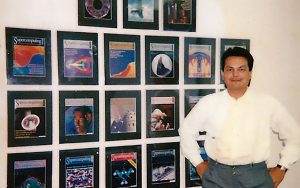May 11, 2023 — The SC23 communications team recently interviewed Tom Tabor, CEO of Tabor Communications, publisher of HPCwire, EnterpriseAI, QCwire and Datanami. Below is that interview, titled “HPC Perspectives: A Conversation with Thomas B. Tabor.” (Link to SC23’s I AM HPC Perspectives)
Thomas B. Tabor has made notable contributions to the electronic publishing sector as an international publishing and media executive. In the late 1980s, Tom was involved in the launch of an online edition of Supercomputing Review magazine, which eventually led to the creation of HPCwire in the early 1990s. Claiming to be the first Internet publication to offer paid subscriptions and advertising, HPCwire is the longest-running industry publication and portal for the high-performance computing (HPC) industry around the globe. Today, Tom is the CEO of Tabor Communications, an international media, events, advertising, and communications organization focused on global computing advances.
An Industry Pioneer
Given his history in HPC publishing, Tom has a unique perspective on industry developments. Tom was kind enough to sit down with us to share highlights from his more than 30-year journey in HPC. In this Q&A, we covered a broad range of topics, including how he got into HPC publishing, highlights from his career, thoughts on industry progress with diversity and inclusion, and what he’s most excited about today in HPC.
Q: This article will be published during Asian American and Pacific Islander Heritage month, and you were born in Guam. I’ll bet it wasn’t a direct route to go from being an islander growing up in Guam to being a publisher covering the leading edge of computing. How did you get into HPC-related news and publishing?

Tabor: I’m bi-racial, Chamorro (Guam) and Caucasian. I grew up in the Chamorro culture, and I celebrate it every day. I was born and raised on Guam, with my mother being an island girl and my father a white World War II Navy guy. Growing up, Guam was a small island focused on family and community, which resonates with me personally, professionally, and culturally. The island’s population was around 50,000 back then, but today it has grown to around 170,000.
Guam’s matriarchal culture had a big influence on me, and I seek out powerful, assertive women who are doers, like my wife, sisters, and mother. This has shaped how I approach life and business, and I’m a strong advocate for gender, ethnicity, and lifestyle diversity in the workplace.
My introduction to the HPC space was random luck. I started my career in publishing and later spent some time working in manufacturing before returning to publishing. When I decided to re-enter the publishing field, I answered an ad for Supercomputing Review magazine, which is no longer around. At the time, I couldn’t even turn on a PC and had no familiarity with technology. Still, they gave me a job, and I quickly became fascinated by the topics we covered and the way technology was transforming and impacting society. Today, it’s not lost on me that I went from an island that is about 30 miles long and 4-8 miles wide to running a publication about the fastest computers in the world. It’s been quite a journey.
Q: You were an early mover in HPC-related publishing. Take us back to the late 80s. How did you come to be involved with HPC publications, and what were you up against?
Tabor: When we were publishing Supercomputing Review, the federal government was the primary customer for HPC. The first Gulf War led to a sudden freeze in HPC spending, which affected our advertising revenue. We lost 75% of our advertising almost overnight, significantly impacting our operating budget. Despite trying to sustain it, the magazine was eventually sold to a Texas publishing group.
Meanwhile, we were developing an Internet-based publication called SuperNET, which I acquired and renamed HPCwire. We called it “wire” to create an association with electronic news services since most people were new to the Internet but generally familiar with wire services versus an electronic news service.
In the very early days, we had only a few employees and ~$500 in the bank, so I burned the midnight oil to build a media kit, and we started creating content. Then one day, I received a call from Joe Grisillo, a VP at Fujitsu, who expressed interest in our work with SuperNET and was interested in supporting us.
After setting up a meeting with him, I put our savings into dressing up our office so we looked as established as possible and gave him a demo using a Mac Classic PC. When I was done, Joe looked at me and said something I didn’t expect: “This looks really cool. How can I help you?” I was expecting him to ask for a proposal, so on the fly, I suggested he could sponsor us. Surprisingly, he immediately agreed to sponsor us for $10,000, which helped us make payroll and attend an SC conference in Minnesota. There, we secured half a million dollars in advertising, and that’s how our journey began. (Editor’s note: SC92 was held at the Minneapolis Convention Center in Minneapolis, and was keynoted by Larry Smarr, then Director of the National Center for Supercomputing Applications (NCSA). He spoke on the topic, “Grand Challenges! Voyages of Discovery in the 1990s.” Tom and Larry both live in La Jolla, California, and are neighbors and still great friends.)
Q: What are you most proud of with respect to Tabor Communications and your history in HPC publishing?
Tabor: One thing I’m most proud of at Tabor Communications is our staff diversity and low employee turnover rate. Many staff members have been with us for over a decade – some over two decades, with the shortest tenure being two to three years. Building a healthy culture contributes to this longevity, and despite ups and downs over the past 30 years, our team’s dedication is what I’m most proud of.
We’ve also had a lot of cool publishing firsts. For example, early on, pre web browser, we built a Bulletin Board System (BBS) that functioned like a webpage. Our editors uploaded content daily, and it was hard to keep up. To address this, I asked our manager to create a weekly synopsis of the content via email. This eventually evolved into an email newsletter with each issue resembling a table of contents, including an article title and abstract, and advertisements.
Next to each article, we added a small box created with brackets. Readers could reply to the email with an ‘X’ in the box to request the full article. Using a simple Unix grep command, we would grab and send the requested article back to the reader. This innovation led to the creation of the world’s first paid subscription, paid advertising publication on the Internet.
Q: Throughout your career, you’ve served as the publisher for a host of publications and events, so you’ve had a front-row seat to HPC industry evolution. What industry developments were most surprising when they happened, and what trends or developments are you keeping a close eye on today?
Tabor: Some of the most surprising and interesting industry developments include the incredible trajectory of HPC technology. When we first started, we dealt with millions of floating point operations per second (MegaFlops), and today we’ve reached a billion billion operations per second (ExaFlops.) Each breakthrough in processing power has increased the ability of HPC to impact society and improve quality of life.
The most disruptive developments are probably the Internet and the web browser, which came out of the HPC field and have generated hundreds of trillions of dollars for the economy. The web browser was developed at the NCSA under the leadership of Larry Smarr.
Today, AI is clearly the next major disruptive technology. About five years ago, I remember talking to Horst Simon, then-deputy director of Lawrence Berkeley National Lab, and asking him when we would start seeing real progress in AI. At the time, he said we were a ways away and that it would likely take exaflop capabilities. Well, we just broke the exaflop barrier last year, and then quickly saw a release of a host of groundbreaking AI tools, including ChatGPT, bringing us all the more closer to Artificial General Intelligence (AGI).
I think these developments will be disruptive in positive ways. HPC, and tech in general, has been built to offload mundane tasks and help humanity focus on more profound endeavors. As technology advances, human cognitive capabilities will advance and adapt. While the rapid pace of change can be intimidating, many people will use these new tools without fully realizing their impact, much like how we use smartphones today.
Q: Since diversity inclusion is so important to you, where do you think the industry has made the most strides, and where is significant work yet to be done?
Tabor: The HPC community is cool and unique in that it’s global but also pretty small, so the efforts to improve diversity are easily identified and their results recognizable. Anecdotally, you can see the progress on the floor at SC, where there are more women and people of color than there ever were very early on. And, it’s great to see outreach efforts to historically black colleges and other diverse institutions.
I think some of the greatest strides have been made through Women in HPC, which is a large and very active community. The Women in HPC mentorship program engages female senior executives from industry to provide guidance to women in their HPC career paths starting in grad school. Access to mentors who can show women the ropes and help them navigate their careers has been an important leap forward for diversity and inclusion in the industry.
Overall, I’m really encouraged by what we’re doing. And, certainly, there’s always more room to grow.
Q: When you look at trends in HPC, what are you keeping a close eye on, and what gets you most excited and why?
What an exciting time to be in HPC! Cloud has democratized access to HPC capability, and we’re on the cusp of Quantum Computing (QC) and Artificial General Intelligence…it’s not a matter of “if,” but “when.” I’m not done because we have so much to explore. In fact, at our Wall Street event last year, we assembled a panel of three leading QC analysts and a futurist to discuss the realities and future of quantum computing. Our goal was to provide the audience with valuable insights and a narrative to share with their leadership, helping them understand what they should be monitoring and striving for in the quantum realm.
It is very cool and a big eye-opener thinking about HPC-related disruptions that are yet to come. Quantum and AI are going to be very disruptive to the point where you can imagine a world where mundane tasks for humans are handed off to systems, and we can focus on benevolence, our quality of life, and equality. I’m an optimist, so I’m really excited about the possibilities.
Source: SC23 Blog



























































